The OnePlus One Review
by Joshua Ho on November 19, 2014 8:00 AM EST- Posted in
- Smartphones
- Android
- Mobile
- OnePlus
Camera UX
For the most part, the OnePlus One has a generally standard camera system for 2014 smartphones. With a 6P lens system, F/2.0 aperture, and Sony IMX214 camera sensor, the OnePlus One has a relatively standard camera system for today's smartphones. The focal length is similar to most smartphones on the market at a relatively wide 3.8mm length, which makes it equivalent to a 28mm focal length when accounting for the crop factor of the sensor. The front facing camera has an OmniVision OV5648 sensor, which is a 5MP, 1.4 micron, 1/4 inch sensor, with an F/2.0 aperture at 2.67mm focal length. This means that the field of view is similar to the rear-facing camera at about 29mm accounting for the crop factor.
While the camera hardware is relatively standard, the camera interface is definitely a unique take, and is the first time that I've been able to use Cyanogen's camera UI. In general, this UI feels like a mix of the old Google Camera, along with an immense amount of complication and not much explanation. For example, in the settings there's an ISO selection menu. While this is nothing to talk about normally, there's a setting called "Auto (HJR)". The only way for me to learn about this setting is by searching for it on Google, which explains that it favors higher ISOs to reduce the effects of shaky hands. As of the latest 44S update, this crashes the camera any time I try to take a photo in low light. To further explain the point, there are plenty of options in the video size setting, but a huge number of them are completely unexplained. While one might easily guess what 4K UHD or HD 1080p is, I find it difficult to believe that 4k DCI, CIF, or QCIF are self-explanatory. Interestingly enough, turning RAW capture on or off also has an effect on the maximum shutter speed, something that isn't actually detailed anywhere.
While an unfamiliar UI is not really a massive issue, there are some fundamental flaws with how the UI works. One of the most obvious flaws is the aspect ratio of the preview, which is 16:9, when output images can have a 4:3 aspect ratio. This makes it impossible to accurately frame an image. In order to do the ISO chart test, it was necessary to use Google Camera to frame the chart before switching back to the Cyanogen camera.
In addition to all of this, the scene selection UI doesn't have much thought put into it. All filters and all scene modes are integrated into a single menu, which is navigated by swiping up and down on the preview. This wouldn't really be an issue but when there are 31 options to swipe through this really gets to be a bit much to handle. There is a list option that can be found by going through the menus though, which is a bit better at organizing information. Unfortunately, most of the scene options are a bit nonsensical. The "night" modes don't actually change anything (ISO and shutter speed seem to be identical), and pretty much everything else is unclear on what it does. The one interesting mode is the slow shutter mode, which sets ISO to 100 and allows the exposure time to go as high as 8 seconds for high-quality photos on a tripod. This is also broken as of the 44S update, which causes the camera to crash until the phone is rebooted. I suspect that OnePlus is better off exposing full manual controls instead of trying to cover every possible edge case with a large number of scene modes that may or may not change anything. There's also no way to get a grid to try and frame images properly.
Speaking of ISO and shutter speed values, while the camera UI was mostly responsive in previous versions, around the 38R OTA I saw a dramatic shift in the auto exposure algorithm as it went from a maximum of 4500 ISO and around 1/11 second shutter speed to 4100 ISO and 1/6 second shutter speed. This has effectively made it impossible to use the camera at night, as there is no OIS present to reduce the effects of even slight hand shake. Overall, all of these issues make the OnePlus One quite frustrating to use as a camera.
Aside from these niggles with the camera application that can generally be resolved by using Google Camera, another area of evaluation is shot to shot latency, along with focus latency. To this end, the device was tested by pointing the camera at the ISO chart with strong lighting to be able to reach base ISO and timing how long the camera took to focus on an object along with how quickly the device could take a photo.
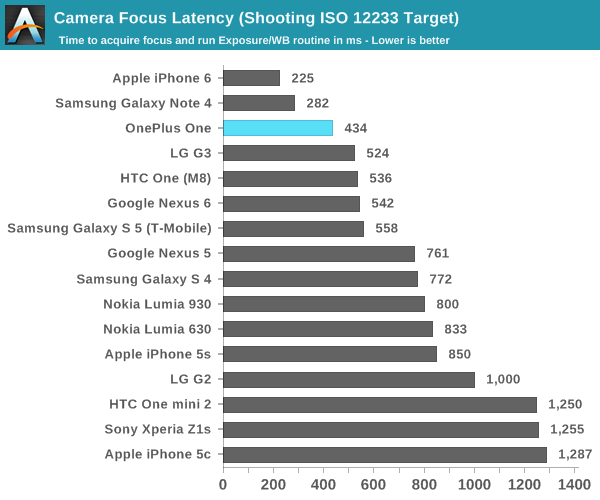
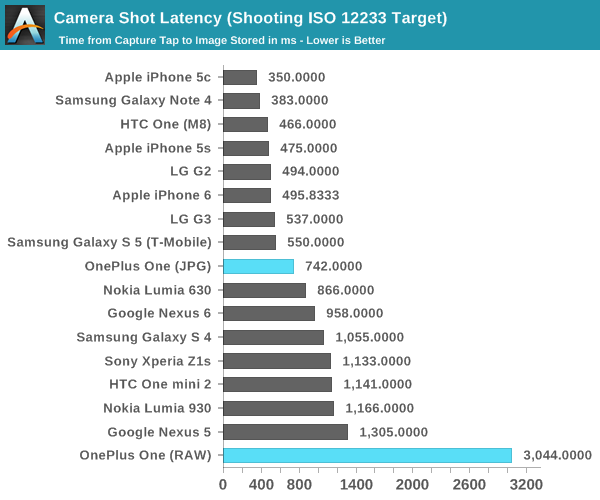
The OnePlus One does do surprisingly well in our focus test, setting a rather respectable focus latency around the same speed as the competition. On the other hand, the default capture speed is really quite long, although this is really mostly due to the RAW capture as turning off RAW capture dramatically speeds up response time in the camera to a much more respectable ~750 ms.


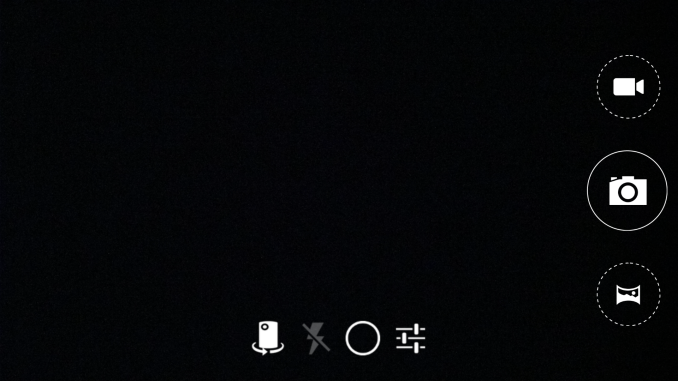

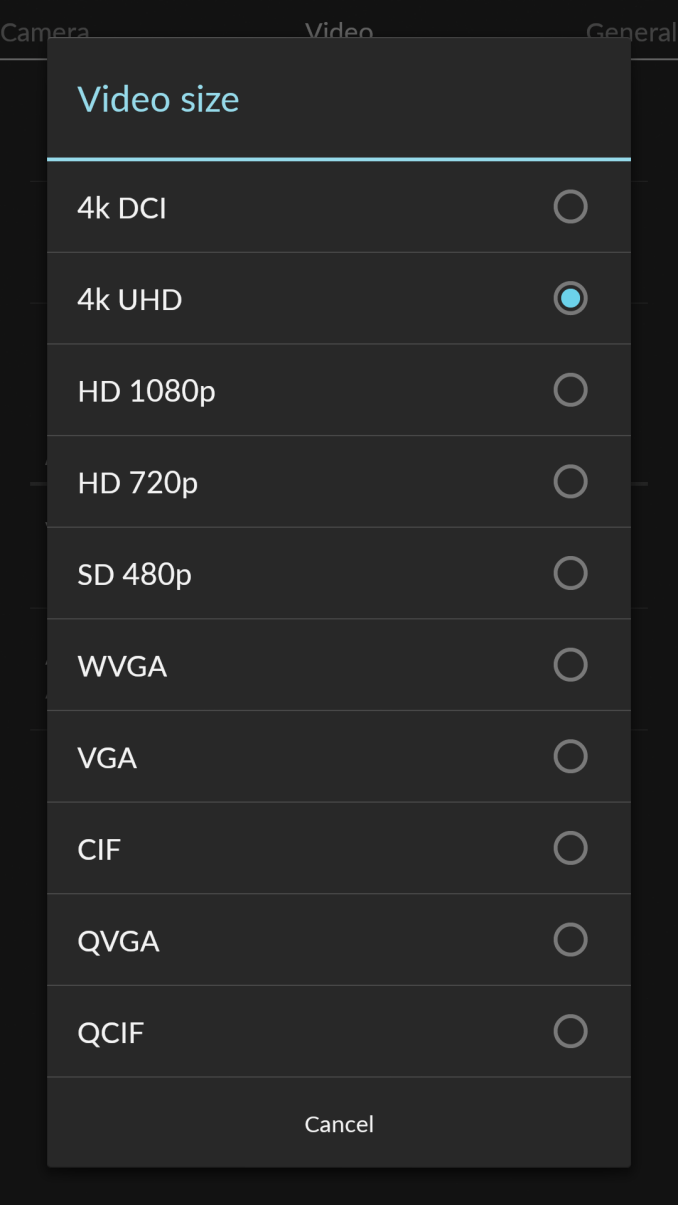


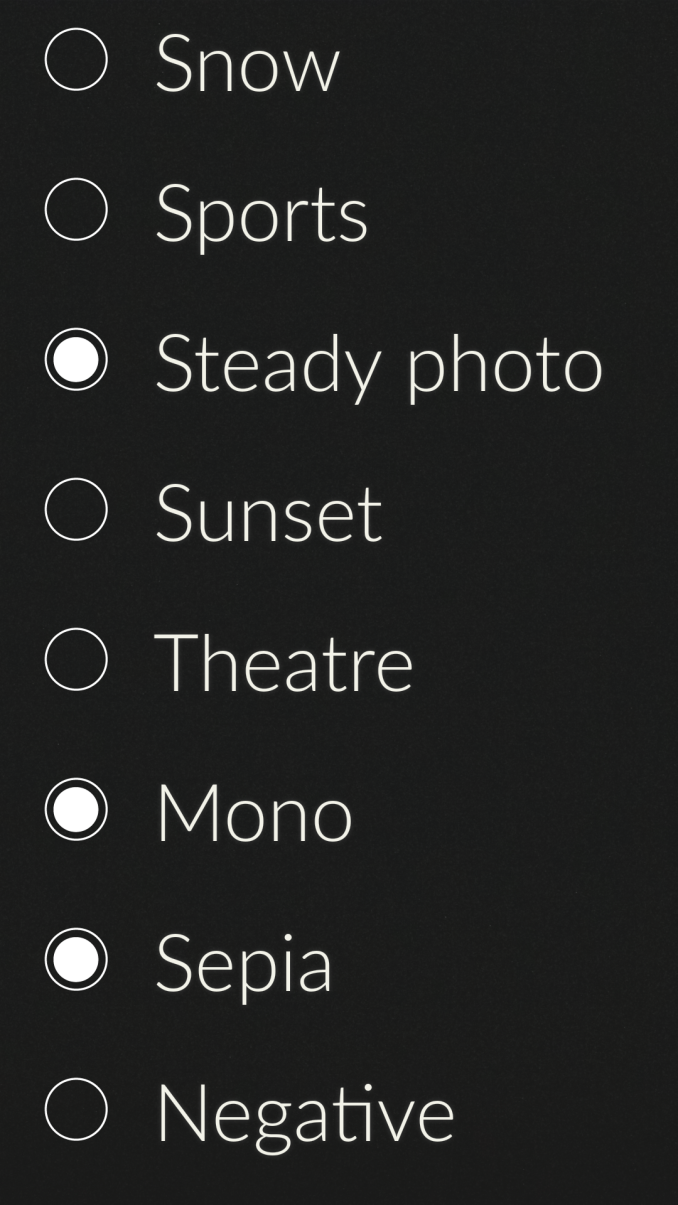
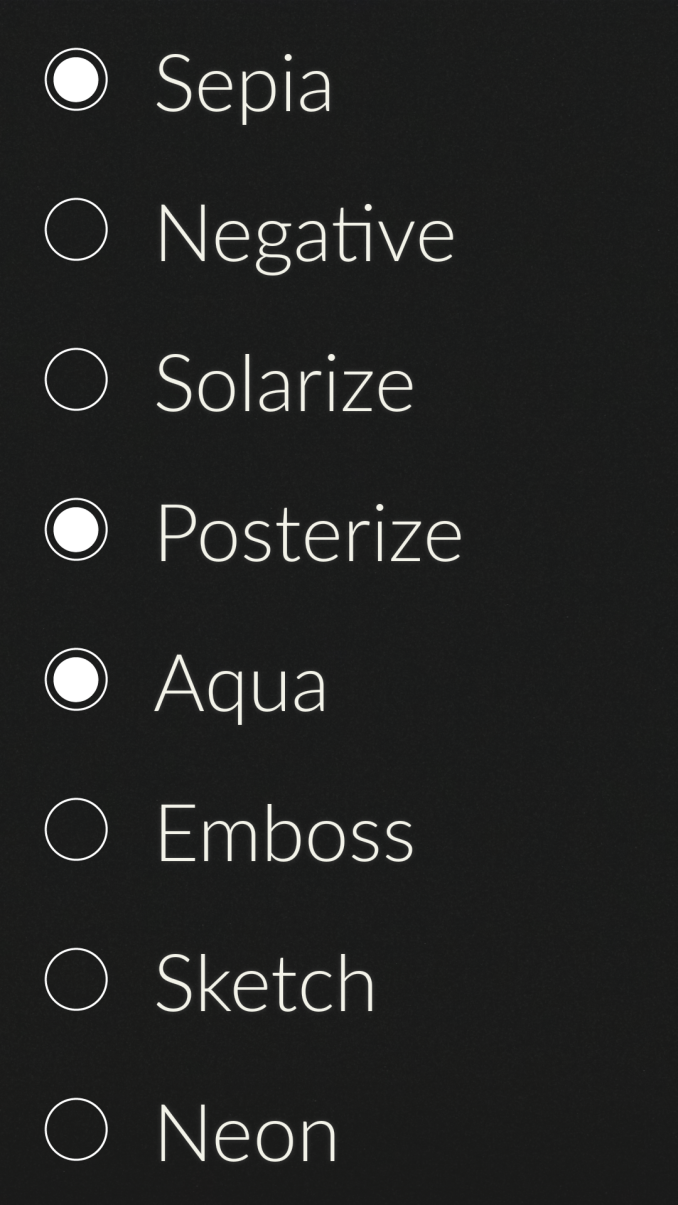
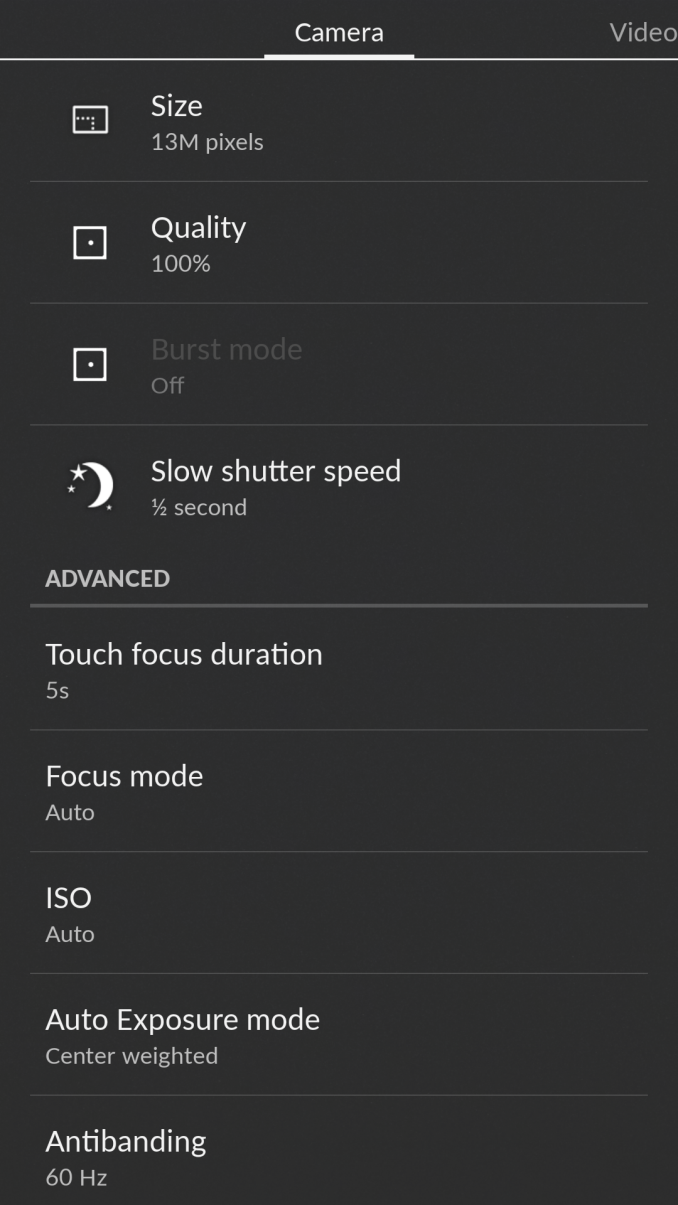









148 Comments
View All Comments
melgross - Wednesday, November 19, 2014 - link
I know this may seem to be a very minor issue and nitpicking, but I would just like to comment that the thinness of the oleophobic coating, if there is one, would have no effect on the feel of the screen. You interact with the surface of the coating, not the thickness. It might lead to a shorter effective life for the coating, but not a difference in swiping feel.I bothers me, because this is something that a little bit of thought would have revealed as being illogical. And if writers write things that are illogical in one part of the article, where else will they do that where we won't notice it, and come to a wrong conclusion because of it?
cr0wb4r - Wednesday, November 19, 2014 - link
I think two options in CM11S will make all the nit picks worthwhile: Profiles and double tap to wake.Having a Home and Work profile allows me to turn off/on lock screen. Huge
Double tap to wake and see notifications and then double tap status bar area to go back to sleep. Again Huge.
Just my 2 cents on the plethora of CM11S options
cr0wb4r - Wednesday, November 19, 2014 - link
Sorry, forgot to mention that Profiles make it AUTOMATIC to turn on/off lock screen. I realize this is obvious to most...phoenix_rizzen - Thursday, November 20, 2014 - link
Profiles have been available in Android ROMs for at least a year now, if not longer. It's one of the first things I turn off when flashing an AOSP-based ROM on my phone.DT2W has been available in Android ROMs within a month or so of LG releasing their sources, as they were the first ones to enable it (works wonderfully with the LG G2 where the power button is on the back).
IOW, neither of these features are exclusive to CM 11S, or even CM, or even just AOSP.
toyotabedzrock - Wednesday, November 19, 2014 - link
I have read that the updated version of Chrome running on lollipop on the nexus 5 sees a rather large bump in the Octane benchmark.Allan_Hundeboll - Wednesday, November 19, 2014 - link
I was beginning to think this site would never review the OPO, much appreciated.But:
Oneplus One has strong reception! (But lacks LTE 800Mhz band)
And people should know that a 5.5" phablet is big, so how can the size be a problem?
Maybe the author also think the iphone 6+ is just too big? Let customers decide what screen size he/she wants, please.
Joshua Ho seem to forget this phone wasn't made for average joes! CM is all about customization so how can too many options be a problem? Please understand a lot of geeks chose android because we appreciate the almost endless possibilities and CM takes this further than google's stock android.
So this phablet is perfect for XDA members NOT for someone like my mother.
mfmx - Thursday, November 20, 2014 - link
Are you sure your mother wouldn't like it? My grandmother that is 96 years old thinks 5,5" is the perfect size for her. Also my mother that has a 5,3" phone doesn't want a smaller device.Munna2002 - Friday, November 21, 2014 - link
My mother and grand aunt also like the size of the OPO.grayson_carr - Thursday, November 20, 2014 - link
The display calibration results are perplexing to me. I know when the phone was first released, it was using a calibration profile created by then CyanogenMod employee François Simond (supercurio), who has also worked with Anandtech on reviews in the past. It didn't surprise me that the screen was very accurate then. But then a couple months ago, OnePlus released an update that did away with supercurio's calibration profile (and let supercurio go / didn't renew his contract) because too many people were complaining that the screen looked too yellow (warm), as 6500K often does to the untrained eye. The update shifted the white point drastically up to the 8000K range (super cold and blue looking) and presumably made colors less accurate. I sold the device a short time later due to annoying bugs, but now I'm confused by these results. What version of CM11S was this phone running as tested? Did you test an old version of the software or did they reinstate the proper calibration profile in a recent update? This review could mislead some people hoping for a properly calibrated screen if you did indeed test the One with the older software.techcrazy - Thursday, November 20, 2014 - link
Where is Sony Xperia Z3 and Z3 Compact review?